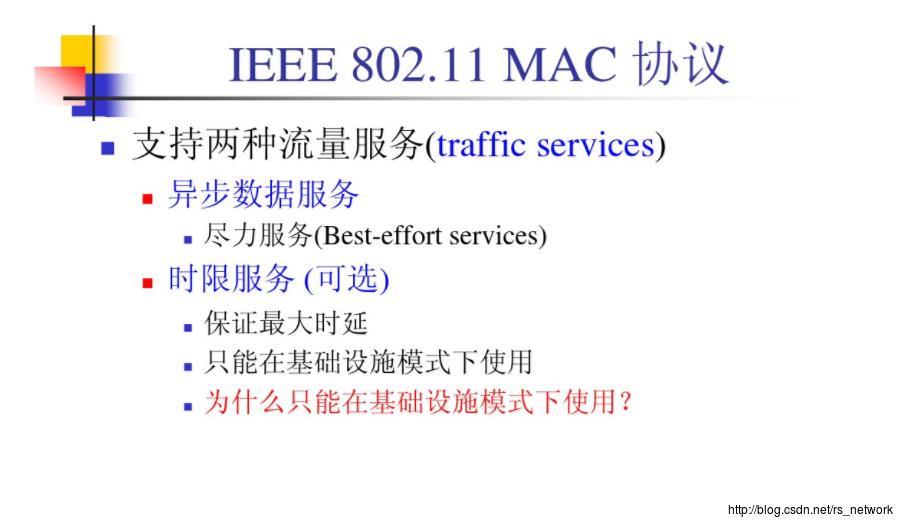有关Best-effort理解的相关资料汇总
Posted Wi-Fi研习者
tags:
篇首语:本文由小常识网(cha138.com)小编为大家整理,主要介绍了有关Best-effort理解的相关资料汇总相关的知识,希望对你有一定的参考价值。
笔者仅仅整理一些笔者目前看到的资料,没有总结,考虑清楚以后再总结。
Ref 1(参考High-Performance Communication networks,高性能通信网络中的定义)
802.11的核心思想还是基于Best-effort。Best-effort的定义包含两个部分:
- IP的承载服务就是以数据报形式发送报文,报文的最大程度为2^16字节(64KB)。这种服务在差错,网络延迟或带宽方面不提供服务质量保证。这样的服务叫做尽力而为(Best-effort)服务,表示网络将尽量提供服务。(参考第103页,4.3.1节中的描述)
- IP承载服务在延迟,带宽和数据丢失方面不能提供任何保证,路由器按同一种方式处理所有的分组(这种“一视同仁”的处理方式也可以叫做尽力而为(Best-effort)服务)。这是一种很自然的特点:缺乏状态信息就意味着分组不能够被应用或链接所区别,这样路由器就不能提供额外的资源以满足应用需求。(参考第120页,4.5中的描述)
Ref 2 (https://wenku.baidu.com/view/a3989dbbfd0a79563c1e725e.html),第33页

Ref 3
(IEEE 802.11 无线局域网,工业电子出版社),第27页,3.1.1节

Ref 4
(https://www.techwalla.com/articles/difference-between-synchronous-and-asynchronous-data-transfer)
- Synchronous
- In synchronous data transfers, the sender and receiver take some time to communicate before they make the exchange. This communication outlines the parameters of the data exchange. This usually involves establishing which end, sender or receiver, will be in control of the transfer. Here, the two parties also ensure they are using the same timing; that is, they know when each burst ends and another begins. They also set parameters for resetting their clocks during the transfer to make sure they don’t drift away from the agreed-upon timing.
- Asynchronous
- In asynchronous, or “best effort” transfers, sender and receiver do not establish the parameters of the information exchange. Rather, the sender places extra bits of data before and after each burst that indicate when each burst begins and ends. It then sends the information, and it is up to the receiver to determine how to reset its clock to match the timing of the signal. Unlike synchronous transfers, the receiver does not take time to communicate to the sender information about what it received.
以上是关于有关Best-effort理解的相关资料汇总的主要内容,如果未能解决你的问题,请参考以下文章